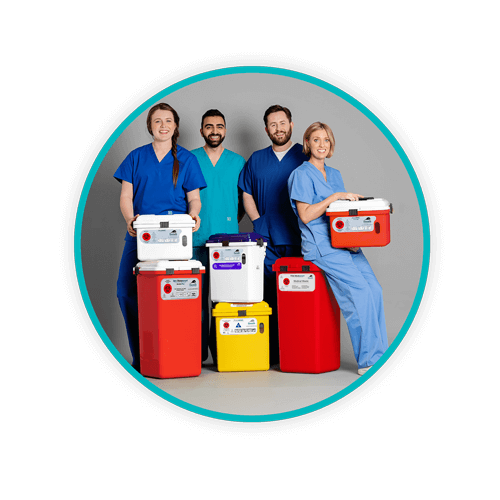Guide to Idaho Medical Waste Regulations

Idaho is less than two million residents spread over its landscape, all of whom require occasional or long-term healthcare services regardless of where their town or city is located in its many areas of rugged wilderness and unspoiled natural areas. From eight-bed hospitals to those that contain over three hundred beds, medical facilities offering a range of care for both its human and animal population generate medical waste.
As many other states, Idaho doesn’t have specific state regulations for medical waste management, but medical and healthcare facilities must nevertheless comply with federal regulations. A number of agencies ensure the safety of healthcare providers, the public, and the environment in the state.
TOPICS WE WILL COVER:
1 / Who makes the rules for medical waste management in Idaho?
2 / Generator size determination
5 / Maintaining compliance for medical waste regulations in Idaho
6 / How Daniels can help you stay compliant
Who makes the rules for medical waste management in Idaho?
The primary regulatory agency that Idaho waste generators must comply with includes the federal Occupational Safety and Health Administration (OSHA) and their Occupational Exposure to Bloodborne Pathogens Standard.
Idaho’s Department of Environmental Quality also provides guidelines in regard to solid waste and hazardous waste management. As such, Idaho’s medical providers and other facilities that produce hazardous waste must be up-to-date and familiar with EPA’s guidance regarding EPA IDs used in tracking hazardous waste, generator size categories, types of hazardous waste, and storage regulations.
Idaho requires that hazardous waste be tracked in the cradle-to-grave approach, meaning from its generation or point of origin to its final disposal. The waste generator is the responsible party in ensuring that all guidelines are followed and that waste is properly disposed of through licensed and approved waste haulers and disposal processes.
EPA ID numbers are required for small and large quantity generators, hazardous waste transportation, treatment, storage, and disposal, among others, which allow states to track activities that are regulated under the EPA’s Resource Conservation and Recovery Act (RCRA). Instructions for obtaining an EPA identification number in Idaho can be found here.
All potential hazardous waste generators should be aware that Idaho has adopted federal hazardous waste regulations found in the Code of Federal Regulations Title 40, Parts 124, 263 to 66, 268, 270, 273, and 279. Idaho state rules found in IDAPA 58.01.05 (Rules and Standards for Hazardous Waste) are also applicable.
To whom do these rules apply? “To owners or operators of commercial sites or businesses that have the potential to generate hazardous waste, or transport, store, treat, and/or dispose of hazardous waste…”
Idaho’s administrative codes in regard to rules and standards for hazardous waste will guide waste generators to federal regulations. Be prepared to reference guidelines found the state’s administrative codes to those found in CFR Title 40 – which primarily focus on protection of human health and the environment.
Generator size determination
Idaho’s Department of Environmental Quality offers a fact sheet titled “Determining Hazardous Waste Generator Size” and the specifications in regard to the volume of waste generated within a calendar month by very small quantity generators, small quantity generators, and large quantity generators. The fact sheet can be accessed through the Idaho DEQ Waste Management and Remediation website resources.
Hazardous waste permits
In Idaho, hazardous waste permits are required for any operation that treats, stores, or disposes of hazardous waste on-site or that is transported off-site, or for a facility that stores their own hazardous waste on-site. Timeframe limits for such storage imply more than 180 days for a small quantity generator or 90 days for a large quantity generator.
Be aware that only permitted facilities can receive a shipment of waste. That waste must be accompanied by a Uniform Hazardous Waste Manifest (8700-22 or 8700-22A) as per Idaho statutes, Title 49 (Motor vehicles), Chapter 22 (Hazardous materials/hazardous-waste transportation enforcement).
The administrative codes of Idaho (IDAPA) also make accessible a document for rules and minimum standards for hospitals (16.0 3.14). As an example, the standards specify that infectious wastes are to be handled and disposed of in accordance with current guidelines and recommendations of the Centers for Disease Control (CDC). These include:
- Cultures and stocks of infectious agents and associated biologicals
- Pathology and medical laboratory specimens
- Human blood and blood products (fluid form) as well as their containers, and liquid body wastes and their containers
- Pathologic waste including organs, tissues, body parts, and so forth
- “Sharps” including needles, syringes, scalpel blades, pipettes, lancets, or glass tubes that can be broken during handling
- Animal carcasses which have been exposed to pathogens, along with their bedding or other waste
- Biohazardous waste Items contaminated with blood or body fluids from patients known to be infected with diseases transmitted by body fluid contact
About sharps disposal
Medical providers and facilities in Idaho are required to comply with federal guidelines in regard to compliant sharps disposal. Used and unused sharps include items or any sharp edged product or tool that can poke, slash, or otherwise pierce the skin. According to OSHA guidelines, sharps must be disposed of in a compliant sharps container that is leak-proof and puncture-resistant.
Sharps containers must also be color-coded red and appropriately labeled to warn of hazardous contents, and must be kept upright to prevent liquids from spilling out of the container.
Maintaining compliance for medical waste regulations in Idaho
An important step in healthcare waste management processes in Idaho is for a generator to determine whether they produce hazardous waste, and second, their generator size.
Hazardous waste manifests are required to track wastes from the generator’s facility to the permitted hazardous waste treatment, storage, or disposal facility. This ensures that the waste generator (the primary responsible party) can verify that wastes have reached their final destination. These manifests or shipping documents must accompany hazardous waste at any point in time it is moved off-site.
Storage, transportation, treatment and disposal of infectious waste for hospitals can be found in Chapter 16 administration rules here. In Idaho, incineration must be conducted in a facility that has been approved and permitted in accordance with the current requirements of the Idaho Air Quality Bureau and must maintain proper temperatures to ensure destruction of all pathogenic organisms.
Steam sterilization is also applicable, as long as standards for temperature settings, proper operational procedures, and periodic testing is performed. Less common methods of disposal and/or treatment include chemical disinfection, thermal inactivation, irradiation, and gas/vapor sterilization. However, efficacy must be demonstrated and monitoring conducted through appropriate procedures and indicators.
Daniels Health promotes compliance
Regardless of population and size of a medical facility, compliance is key. Daniels Health is dedicated to protecting not only healthcare providers, but patients, the general public, and the environment from potentially careless or dangerous actions that result from non-compliant medical waste management processes and disposal procedures. For more information regarding products, services, and guidance when it comes to medical waste management in your state, contact Daniels Health today.
Let's Talk!
Your time is valuable, and we don’t want to play hard to get. You can either phone us directly on the details listed on our contact page, or feel free to fill out this short form and one of our team members will get back to you as quickly as possible.
